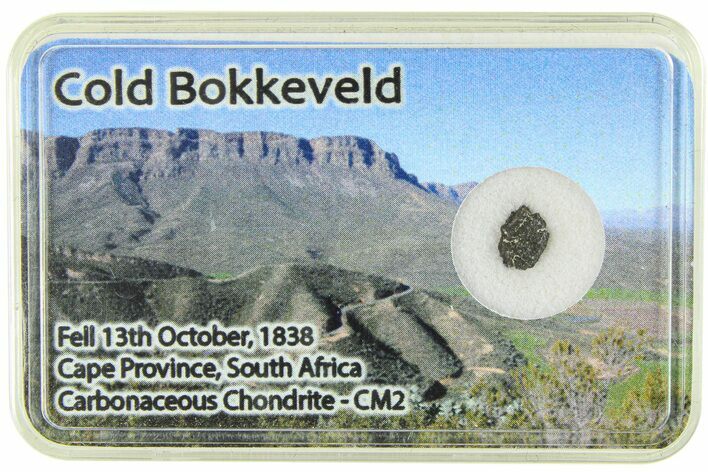.21" Carbonaceous Chondrite Fragment (0.06 g) - Cold Bokkeveld
This is quite the astronomical specimen: a .21" wide fragment of the Cold Bokkeveld meteorite!
Cold Bokkeveld is the name given to a meteorite that fell in the Kouebokkeveld ("Cold Buck Shrubland" in Afrikaans) mountain region in southwestern South Africa. It hit the Earth mid-morning on October 13, 1838: fragments fell in a strewn field around the area. Several eyewitnesses reported the fireball in the sky and the subsequent sonic boom, as well as fragments falling and smoking in the grass. It is the fourth largest observed CM2 chondrite fall in history with a total known mass of about 5.2 kilograms.
Cold Bokkeveld is a CM2 carbonaceous chondrite, a very rare and primitive kind of chondrite that has a nearly identical composition to the Sun, and about as old at 4.5 billion years! Like many CM2 chondrites, it is a handsome brecciated stone with whitish to gray clasts and chondrules set in a dark gray to black matrix. it also contains trace amounts of organic and volatile compounds, as well as evidence of hydrous minerals and calcium-aluminum rich inclusions (CAIs). This class of meteorite is incredibly rare and sought after for not just its beauty but its scientific value, giving researchers a rare look into the beginning of the solar system.
Cold Bokkeveld is a CM2 carbonaceous chondrite, a very rare and primitive kind of chondrite that has a nearly identical composition to the Sun, and about as old at 4.5 billion years! Like many CM2 chondrites, it is a handsome brecciated stone with whitish to gray clasts and chondrules set in a dark gray to black matrix. it also contains trace amounts of organic and volatile compounds, as well as evidence of hydrous minerals and calcium-aluminum rich inclusions (CAIs). This class of meteorite is incredibly rare and sought after for not just its beauty but its scientific value, giving researchers a rare look into the beginning of the solar system.
About Chondrites
A chondrite is a stony (non-metallic) meteorite that has not been modified by either melting or differentiation of the parent body. Chondrites are formed when various types of dust and small grains in the early Solar System accreted to form primitive asteroids. Some such bodies are captured in the planet’s gravity well and pulled to the surface. They are by far the most common type of meteorite, representing about 86 percent of all meteorites that have fallen to Earth.
Prominent among the components present in chondrites are the enigmatic chondrules, millimeter-sized spherical objects that originated as freely floating, molten or partially molten droplets in space; most chondrules are rich in the silicate minerals olivine and pyroxene. Chondrites also contain particles of various metals such as nickel, iron, and aluminum. These formed at the very beginning of the solar system and aggregated over time: they are the oldest rocks known on Earth!
Chondrites are divided into about fifteen distinct groups on the basis of their mineralogy, bulk chemical composition, and oxygen isotope compositions. The various chondrite groups likely originated on separate asteroids or groups of related asteroids. Each chondrite group has a distinctive mixture of chondrules, refractory inclusions, matrix (dust), characteristic chondrule sizes, and other components. Other ways of classifying chondrites include weathering and shock. The L chondrite group is the most common of these.
A chondrite is a stony (non-metallic) meteorite that has not been modified by either melting or differentiation of the parent body. Chondrites are formed when various types of dust and small grains in the early Solar System accreted to form primitive asteroids. Some such bodies are captured in the planet’s gravity well and pulled to the surface. They are by far the most common type of meteorite, representing about 86 percent of all meteorites that have fallen to Earth.
Prominent among the components present in chondrites are the enigmatic chondrules, millimeter-sized spherical objects that originated as freely floating, molten or partially molten droplets in space; most chondrules are rich in the silicate minerals olivine and pyroxene. Chondrites also contain particles of various metals such as nickel, iron, and aluminum. These formed at the very beginning of the solar system and aggregated over time: they are the oldest rocks known on Earth!
Chondrites are divided into about fifteen distinct groups on the basis of their mineralogy, bulk chemical composition, and oxygen isotope compositions. The various chondrite groups likely originated on separate asteroids or groups of related asteroids. Each chondrite group has a distinctive mixture of chondrules, refractory inclusions, matrix (dust), characteristic chondrule sizes, and other components. Other ways of classifying chondrites include weathering and shock. The L chondrite group is the most common of these.
SPECIES
Carbonaceous Chondrite (CM2)
LOCATION
Kouebokkeveld Mountains, Cape Province, South Africa
SIZE
.21" wide, 0.06 grams
CATEGORY
ITEM
#285974
 Reviews
Reviews









